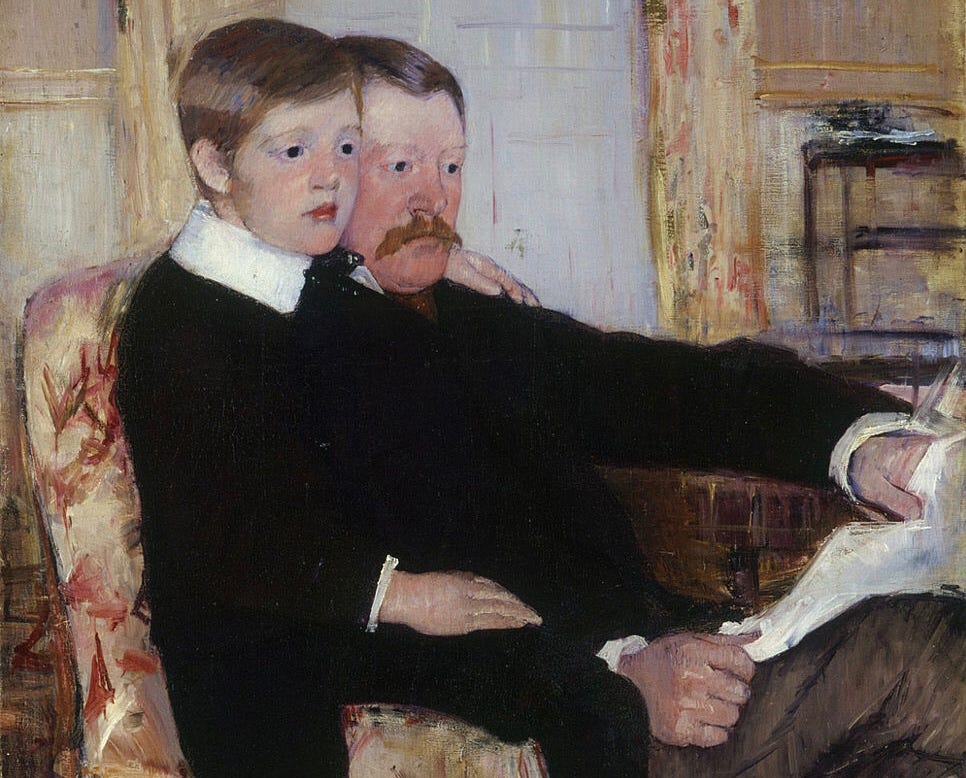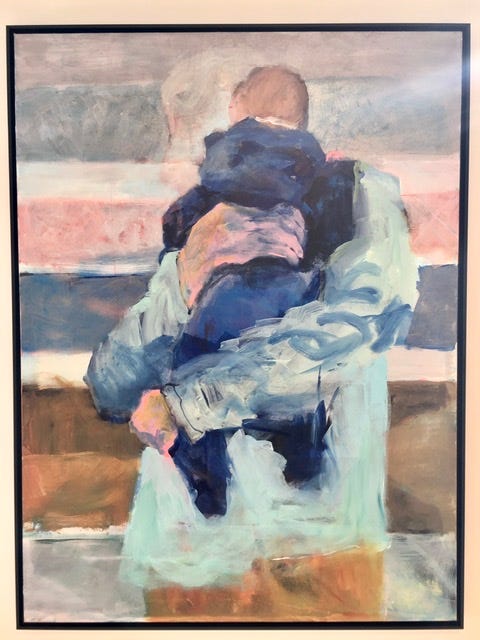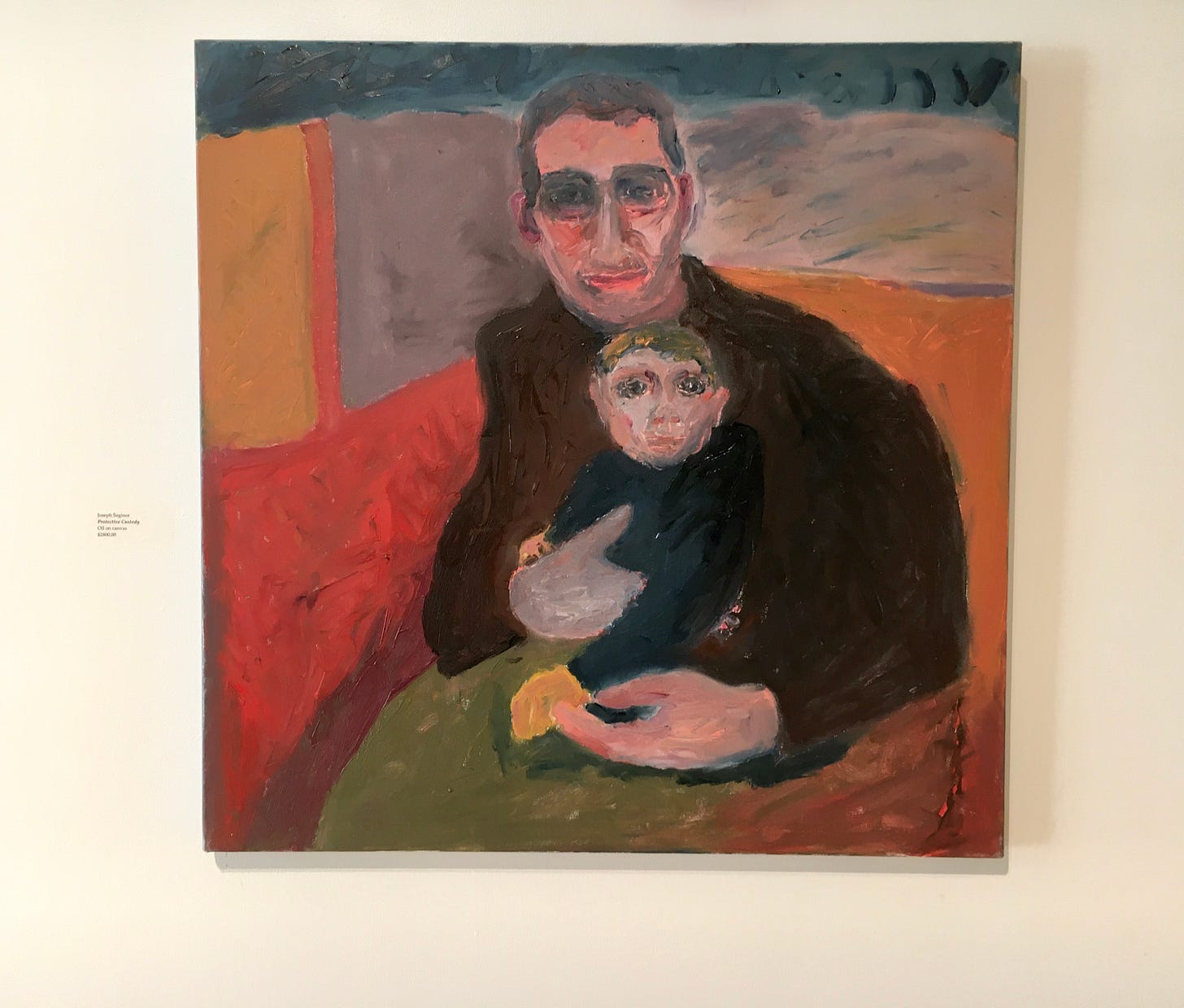Two paintings I saw at an exhibition recently at AVA Gallery intrigued me. At first, I couldn’t quite put my finger on why. Then I realized I had seen few like them.
Think of paintings that feature women and children. No doubt you’ve seen hundreds, if not thousands, of paintings of the Madonna and Child. Two Impressionists—Berthe Morisot and Mary Cassatt—spring to mind, their works often depicting mothers holding and tending to their children in everyday, intimate interactions. Google “women and children in paintings” and you’ll be bombarded with references, like “A Celebration of Famous Mothers in Art,” and “10 Famous Mother and Child Paintings.”
But if you Google “men and children in paintings,” no such bombardment, except for references to multiple articles trying to explain why the infants in pre-Renaissance Madonna paintings all look like little old men. (Fascinating, but not exactly relevant here.)
To be sure, paintings with men and children exist, but there are far fewer of them. (Here are some random examples in contemporary art, and more from an article in the Smithsonian on the subject—though, interestingly, some are of photographs rather than paintings.) Cassatt did paint a portrait (reproduced in part, top) of her brother Alexander Cassatt and his son, showing a young boy with his arm across his father’s shoulders, dad appearing rather formal and staring into the distance, hands gripping his newspaper. Try to think of a famous painting of a man tending to children, and if you can come up with one, try thinking of a second.
Perhaps the seeming dearth of paintings of men holding or tending to children should come as no surprise. The Madonnas come from eons of art with religious themes, and Mary is revered as the mother of the infant Jesus. (Found but a handful of paintings of the infant with foster father Joseph.) And people paint what they see. In Cassatt’s time, children were the province of mothers (or mother surrogates) when it came to caretaking. And one explanation may be the fact that the domestic sphere was considered more “appropriate” as a subject for women artists. Regarding Cassatt: “There would have been places she couldn’t go, even if she had dared,” explains Kimberly A. Jones, a curator of 19th-century French paintings at the National Gallery of Art in Washington D.C. “Even as a friend of Degas, she couldn’t go backstage at the Opera or hang out in the cafés.” Men frequented the public spaces, and painted them.
Some male artists have indeed used their own children as subjects, but the children appear on their own (see this lovely depiction of his daughters by Thomas Gainsborough) or sometimes with their mothers. When men appear with children in portraits, my quick survey shows them more often with the mother included as well, dad (or paternal figure) as the male component of a traditional nuclear family.
Not one, but two paintings currently on view at AVA Gallery are contemporary representations of paternal figures holding children. In “Loving Arms,” (below) Jonathan Rose depicted a standing male figure with a small child nestled in his arms.
The composition of Joseph Saginor’s painting, “Protective Custody,” (below) is reminiscent of a sitting Madonna and Child. Of it, he says, “The painting represents my response to the last two pandemic years and highlights, especially for parents of young children, the desire to protect them from danger. . . To me the most salient feature of the painting are the four hands, which represent the parental/paternal connection.”
It’s a fresh look at the subject of parent and child. As more men find themselves or are observed in caretaking roles, contemporary art and artists may reflect the change. May we see more.
(Underlined text = a hyperlink. Click on hyperlinks for more information or reference.)
————————————————
Welcome! You’re reading Artful, a blog about arts and culture in the Upper Valley, and I hope you’ll subscribe and then share this with your friends and on your social media.
And in case you are wondering . . . Susan B. Apel shuttered a lifelong career as a law professor to continue an interest (since kindergarten) in writing. Her freelance business, The Next Word, includes literary and feature writing; her work has appeared in a variety of lit mags and other publications including Art New England, The Woven Tale Press, The Arts Fuse, and Persimmon Tree. She connects with her neighbors through Artful, her blog about arts and culture in the Upper Valley. She’s in love with the written word.





